One of the main reasons I have for heading to Turkey was Pamukkale, a small town known for the mineral-rich thermal waters flowing down the gleaming white calcite travertines (terraces). When I first saw it on Instagram, I could not believe that such a beautiful and historic attraction still exists today. When I finally saw it in real life, it was everything I imagined and more. If you ever find yourself in Turkey, do not miss this wonderful attraction.

Table of Contents
About Pamukkale and Hierapolis
The ancient spa city of Hierapolis was founded in the 2nd century B.C.by the Attalid Kings from the Hellenistic dynasty, the dynasty that ruled the city of Pergamon in Asia Minor (Asian part of Modern Turkey). The city was founded so that visitors can get access to the warm, mineral-rich waters coming from mountains flowing down the travertines. Hierapolis became prosperous because many people have come here for centuries in the hope of cures for many diseases and ailments.

How to get to Pamukkale and Hierapolis
From Istanbul
There are various ways to get to Pamukkale depending on where you are coming from. You can fly out via Turkish Airlines and Pegasus Airlines from Istanbul’s Sabiha Gokcen International Airport or the brand-spanking new Istanbul Airport to Denizli Çardak Airport, the closest airport to Pamukkale. From there, you can take a Bay Tur shuttle bus to get to Denizli Otogar (bus) station. Then, catch a mini bus or van going to Pamukkale town.
From Selcuk
Take a local train to Denizli from Selcuk Train Station. From there, walk towards Denizli Otogar (bus) station and catch a minibus to get to Pamukkale. It will take about 3-4 hours to get to Pamukkale town.
From Cappadocia
Take a direct bus from Nevşehir (Cappadocia) to Denizli. It will take approximately 10 hours Denizli Otogar (bus) station so it’s best to take the overnight bus. From there, catch a minibus to get to Pamukkale town. It’s going to be a long bus ride so pack some travel blankets and neck pillow for a more comfortable journey.

Where to stay in Pamukkale
After over 4 hours of land travel from Selcuk to Denizli then Pamukkale, we finally reached Melrose Viewpoint Suites, our hotel for the night, where I nearly passed out at the excitement of having to lie down in a nice bed. And then I actually passed out from exhaustion.
Self-Guided Tour of Pamukkale
Our second day began early but I did not complain because visiting the travertines early means we will be free from busloads of day-trippers. We had a delicious and filling breakfast at our hotel’s cafeteria then we asked the receptionist on how to get to the travertines on our own. It turned out, our hotel was just about 10-minute walk to the foot of the travertines.
We walked from the village and watched the travertines come closer and bigger. When we reached the entrance, we bought admission tickets which cost 35 lira per person and allows access to both Pamukkale travertines and Hierapolis.

Since UNESCO declared Pamukkale-Hierapolis a World Heritage Site, protective measures were imposed to prevent further damage and erosion. At the start of the foot path to the travertines, shoes should be taken off. Tourists are only allowed to walk on certain sections. Fortunately for us, we had much of the lower sections of the travertines to ourselves and we were able to freely traipse around without much disturbance from other tourists. It was really a great idea to stay overnight in the village rather than visiting Pamukkale on a day-tour.
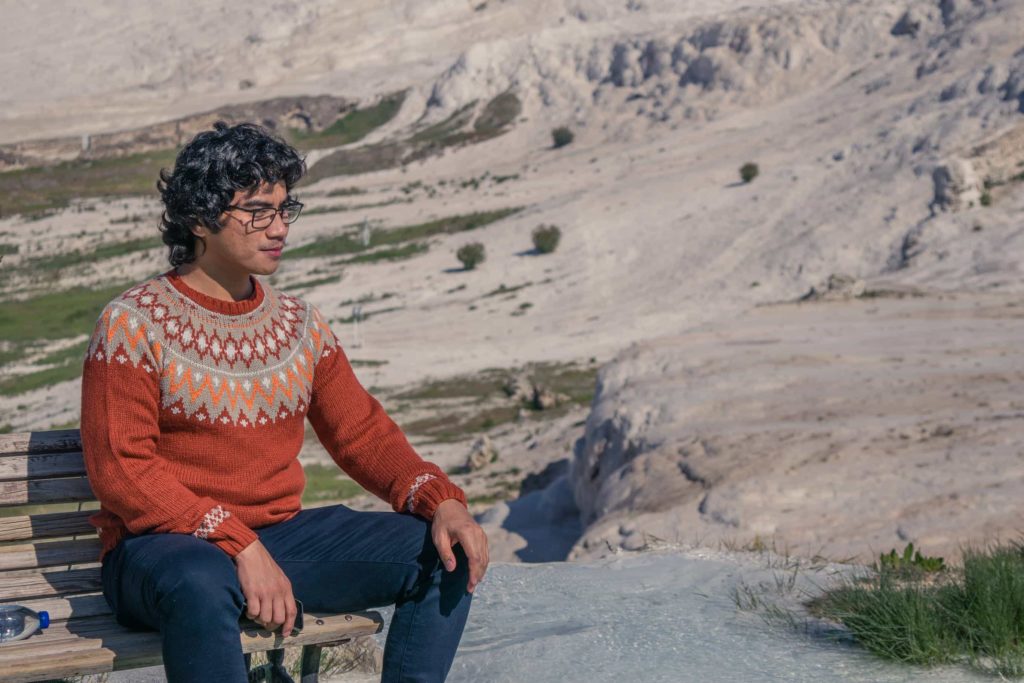
Over the next two hours, my friend and I walked up and down the travertines for a foot spa and of course photo op. We saw a few tourists taking a quick soak, but we decided not to because it was cold. It was supposed to be warm that day because it was almost spring, but it felt like winter. We were very lucky because most of the travertines were not dry and we were able to see the most beautiful section, off-limits to tourists, filled with powdery-looking blue water. It was so magical. I have never seen anything like that ever and all I could do was keep myself from crying tears of happiness.



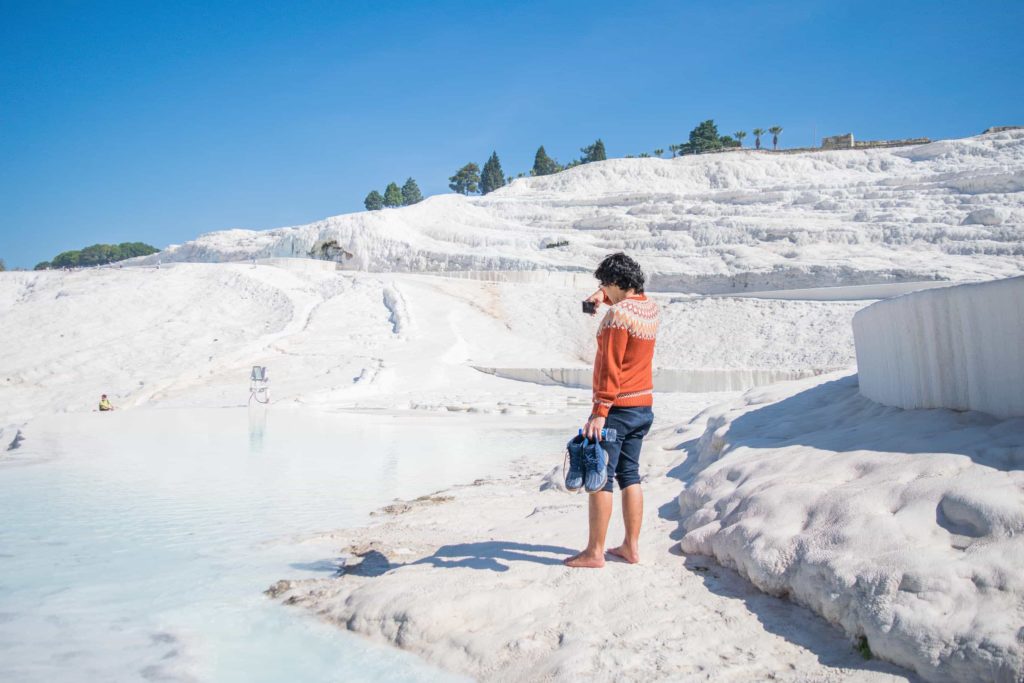

The off-limits section of Pamukkale Travertines
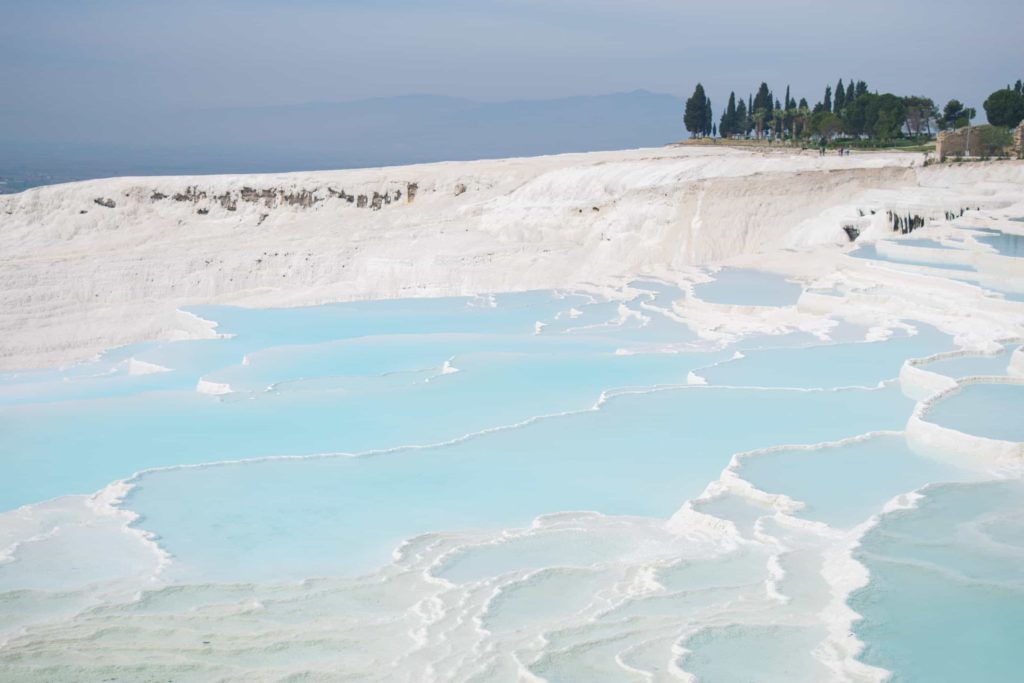

Soaking in Cleopatra’s Ancient Pool
At the top of Pamukkale travertines, just before the entry to Hierapolis, we found Cleopatra’s Ancient Pool. Part of the ancient Hierapolis city complex, Cleopatra’s Pool have been used as a healing spa from as early as 2nd century B.C. What’s interesting about this pool is the remains of the marble columns from the nearby Temple of Apollo which fell into the pool during a massive earthquake in 7th century A.D.
Today, the columns were still in the pool, which is pretty amazing, no? There is no doubt travel enthusiasts and history buffs are attracted to this place. According to some online sites, this artificially sculpted pool was a gift to Cleopatra from Marc Anthony. However, there is no historical evidence if Cleopatra ever visited Hierapolis.
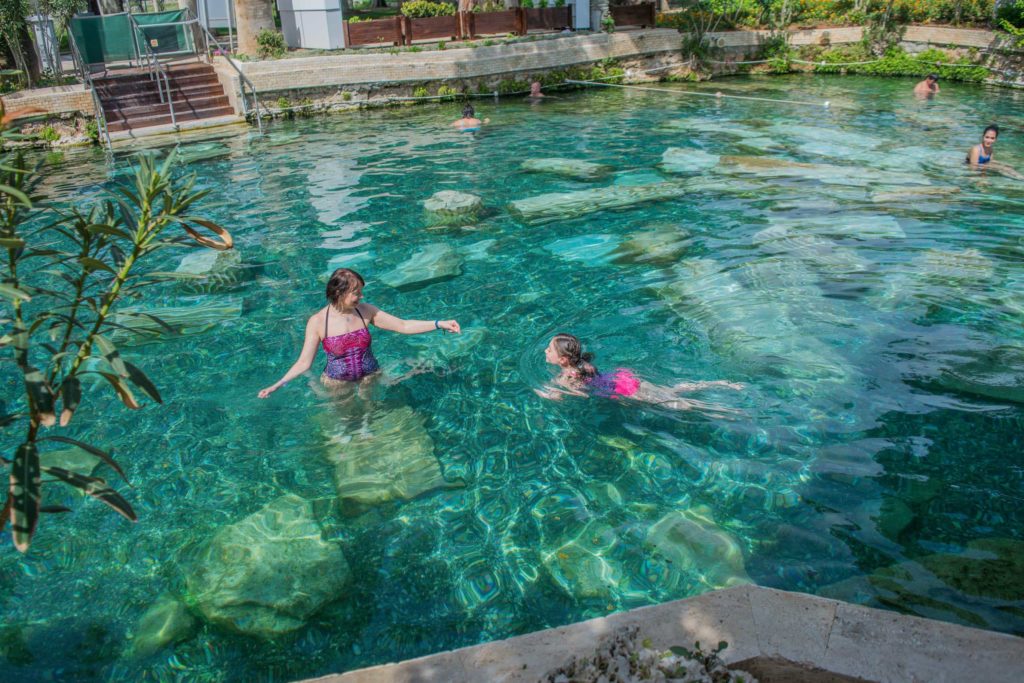
Walking around the Ancient City of Hierapolis
I was surprised to see Hierapolis without the hordes of tourists. There aren’t many tourist guides either. My friend and I enjoyed walking up hill to see the ruins near Cleopatra’s Antique Pool. Much of Hierapolis were in ruins but “The Theater” survived and still looked magnificent. It is without a doubt one of the finest remnants of the Roman Empire.
Aside from the beautiful historical ruins, Hierapolis is said to be where you will find the “Gates of Hell.” Ancient people believed that the Greco-Roman temple known as “Plutonium” was the passageway to the underworld. We weren’t able to visit it though because we were pressed for time.

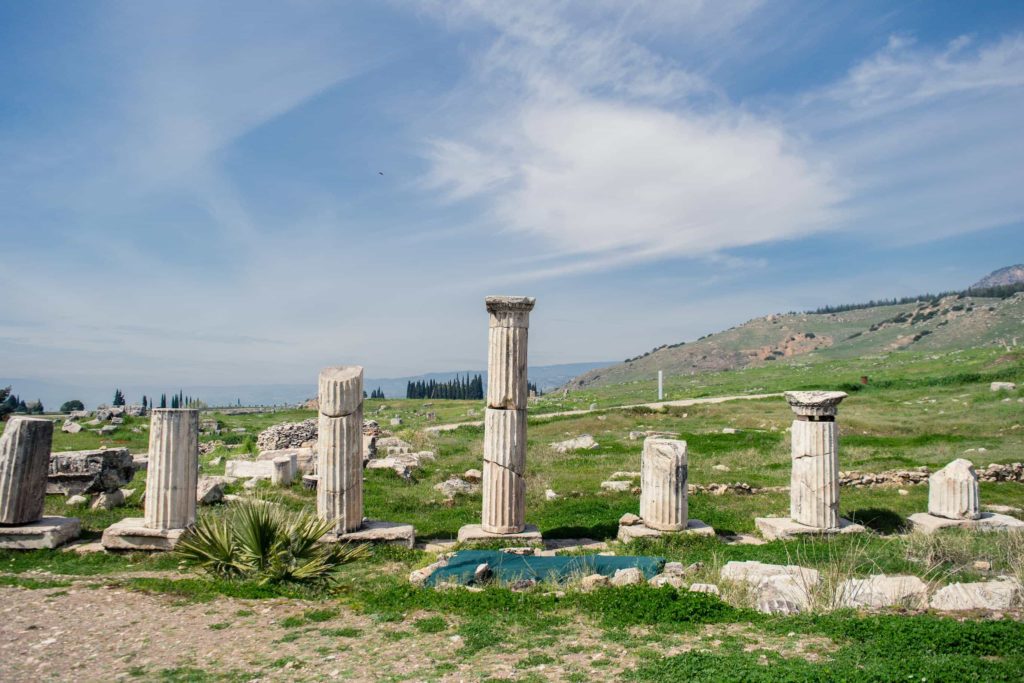
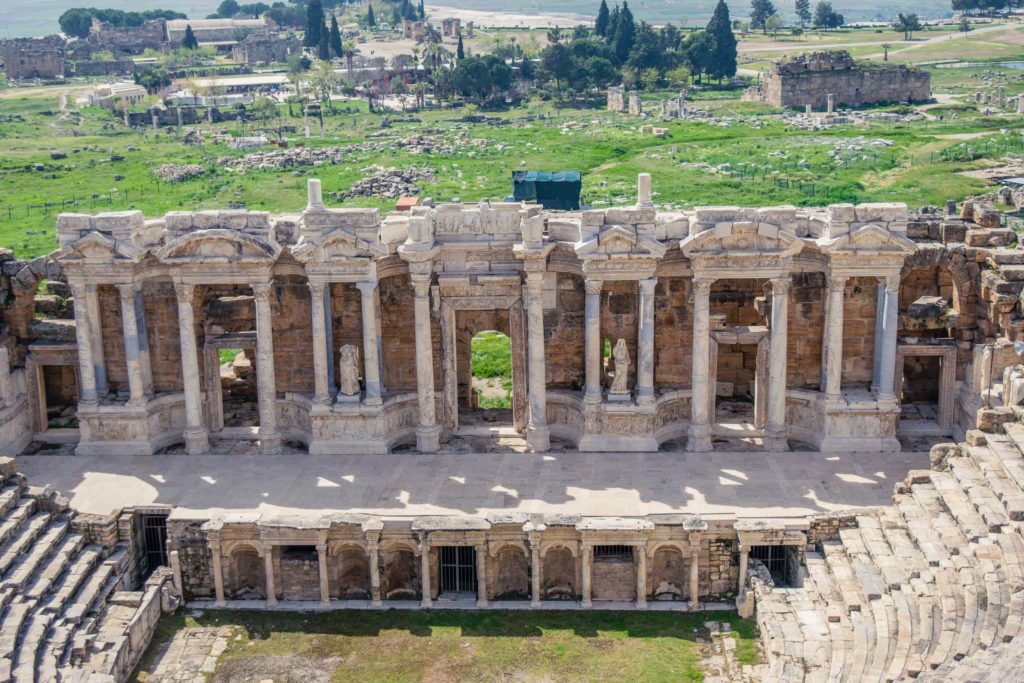
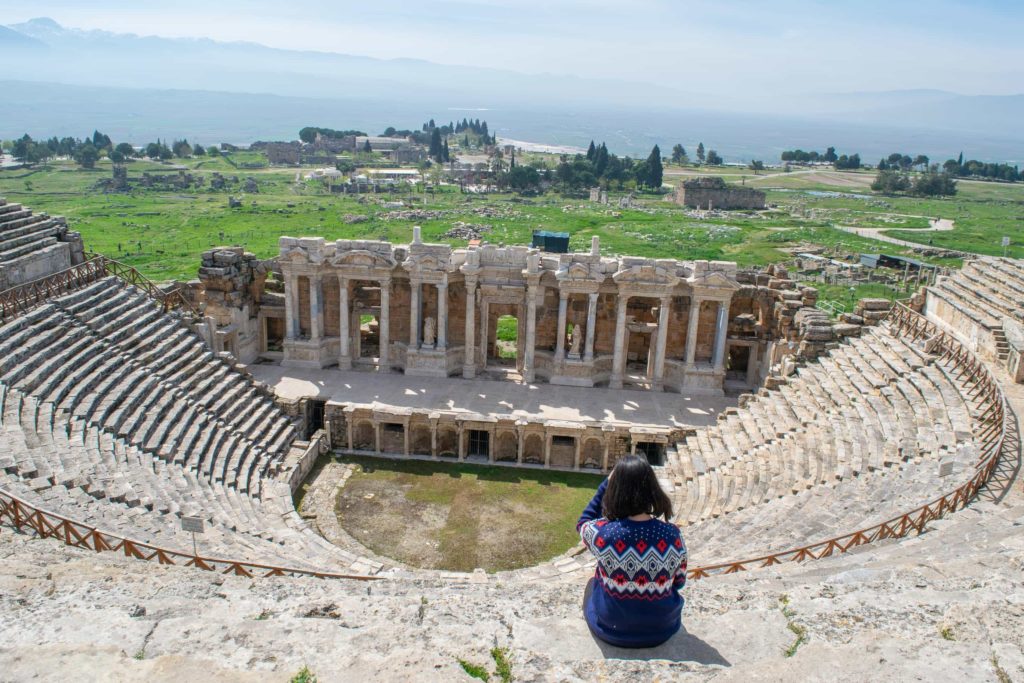
Things to remember before you visit Pamukkale and Hierapolis
- Carry an eco bag to put your shoes in.
- Bring a swimsuit and towel if you want to soak in the travertines and Cleopatra’s Ancient Pool.
- Wear a sunscreen, always.
- Bring snacks and water as food in the travertines are expensive, at least by Filipino standard.
- Stay overnight to avoid the bus-loads of day-trippers. Make sure to go to the travertines early or later in the afternoon.
- If you have time, stay for sunset as the view from the travertines are amazing.
- Read about the history of Pamukkale and Hierapolis before your visit.
Stay connected in Turkey
Whether you are travelling to Turkey for vacation or a business trip, a pocket WiFi should be a non-negotiable. Public places in Turkey do not offer free WiFi so it is challenging to stay connected to family and friends as well as navigate or research for your trip. To enjoy a secure, fast Internet connection and portability that a Pocket WiFi provides, make sure to rent your own device from Alldaywifi. Use my promo code ‘PROJECTGORA10’ to get 10% off!
How about you? Is Pamukkale part of your bucket list? Or have you been here before? How was your experience? Let’s chat down below!

